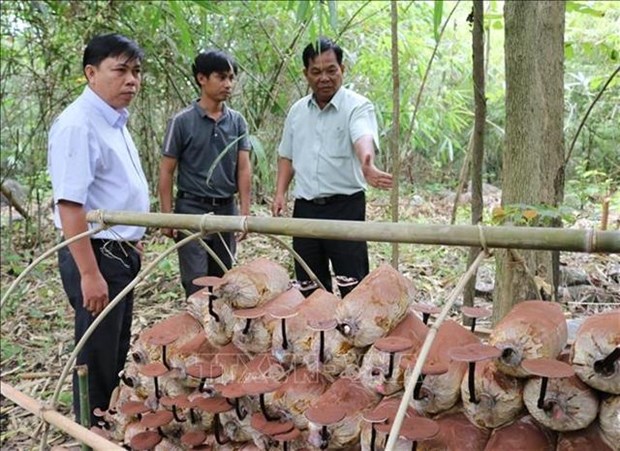
Experts from the Phuoc Binh national park checking the mushrooms planted under the forest canopy. (Photo: VNA)
The research was part of a project titled ‘Conservation of Linh Chi genetic sources originating from the Phuoc Binh National Park’.
The three-year project was carried out by the Phuoc Binh National Park Management Board in cooperation with the Ninh Thuận Science and Technology Department, the Ho Chi Minh City Institute of Biotechnology and Food, and the Institute of Food Supplements.
The project was estimated to cost 2 billion VND (86,700 USD).
According to Luu Van Luong, an expert from the park, the research group conducted several surveys to collect all kind of Linhzhi mushrooms in the national park as well as test their DNA to name 8 species and add them to list of fauna and flora.
Based on the results, the national park successfully classified and conserved two kinds of mushrooms, namely the Ganoderma Lucidu (red Linhzhi) and Humphrey endertii (black Linhzhi), said Luong.
The genetic preservation was implemented under the off-site or ex-situ conservation method in laboratories.
A model of conserving and producing the red and black Linhzhi in mushroom houses and in semi-natural conditions under the forest canopy was carried out by the park.
The model was evaluated by the researchers before being transferred to local farmers for production, said Luong.
The research indicators showed that it took 68 days from seeding to harvest for the red mushroom and 88 days for the black ones.
The interval between harvests was 10 or 12 days. The mushroom would bring 3 crops if they had good care.
On an area of 30sq.m, the yield of red Linhzhi was nearly 24kg of dry mushroom per 1,000 embryos while black Linhzhi’s yield was 12kg.
Nguyen Tuan Anh, vice head of the park’s international cooperation section, said the Linhzhi gene conservation project had an important meaning in genetic resource preservation to the rare Linhzhi mushrooms of Ninh Thuan province.
The national park has cooperated with scientific agencies to conduct research to analyze and publish medicinal active ingredients of the Linhzhi originating from the park, Anh said.
At present, the park had taken 5 households to grow the mushroom as a trial, while offering financial assistance for setting up gardens and providing mushroom embryos.
According to the park’s experts, growing the mushrooms was simple and cheap so it was suitable for poor households./.
VNA
 Da Nang invests over 200 billion VND in semiconductor chip design, AI development
Da Nang invests over 200 billion VND in semiconductor chip design, AI development



